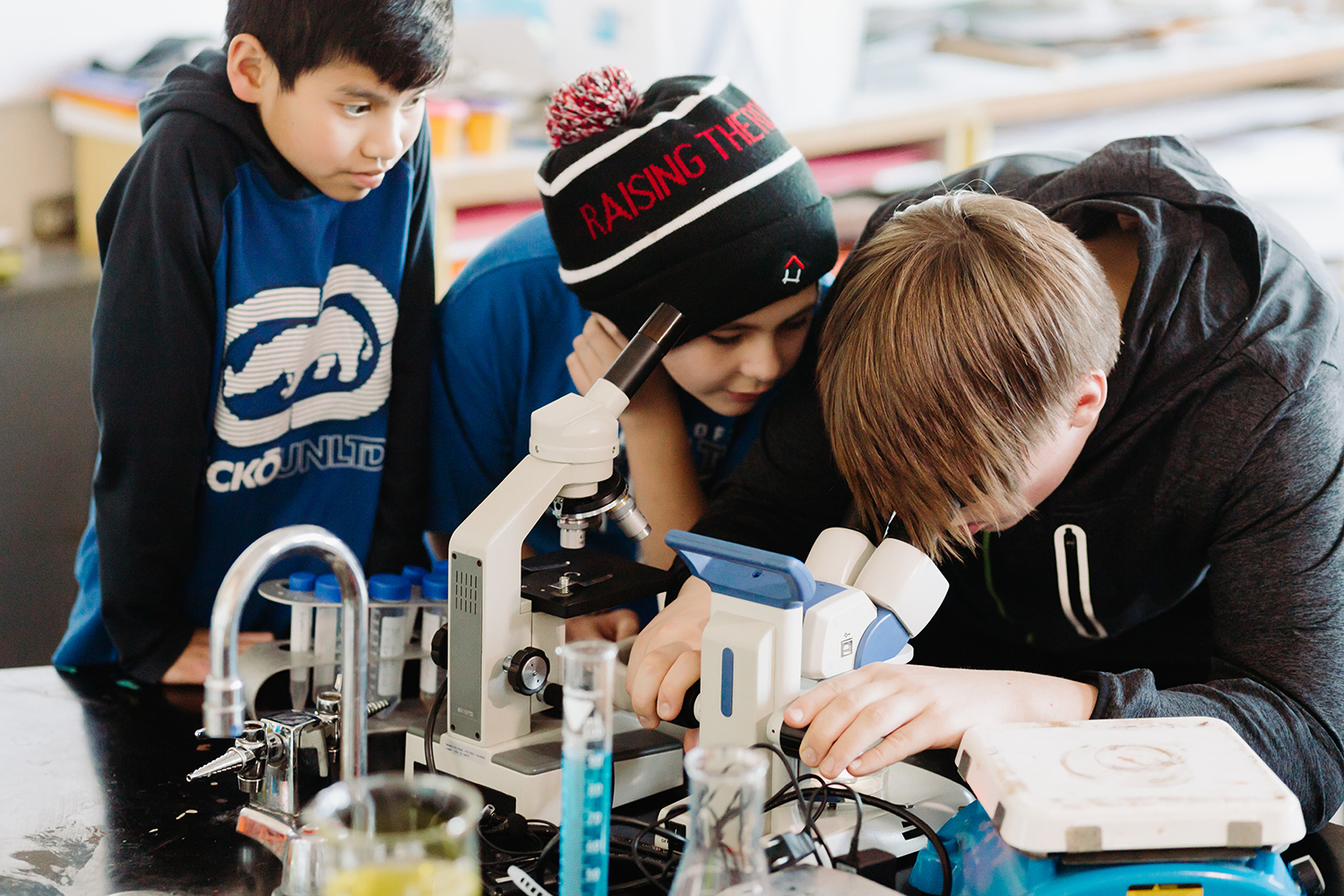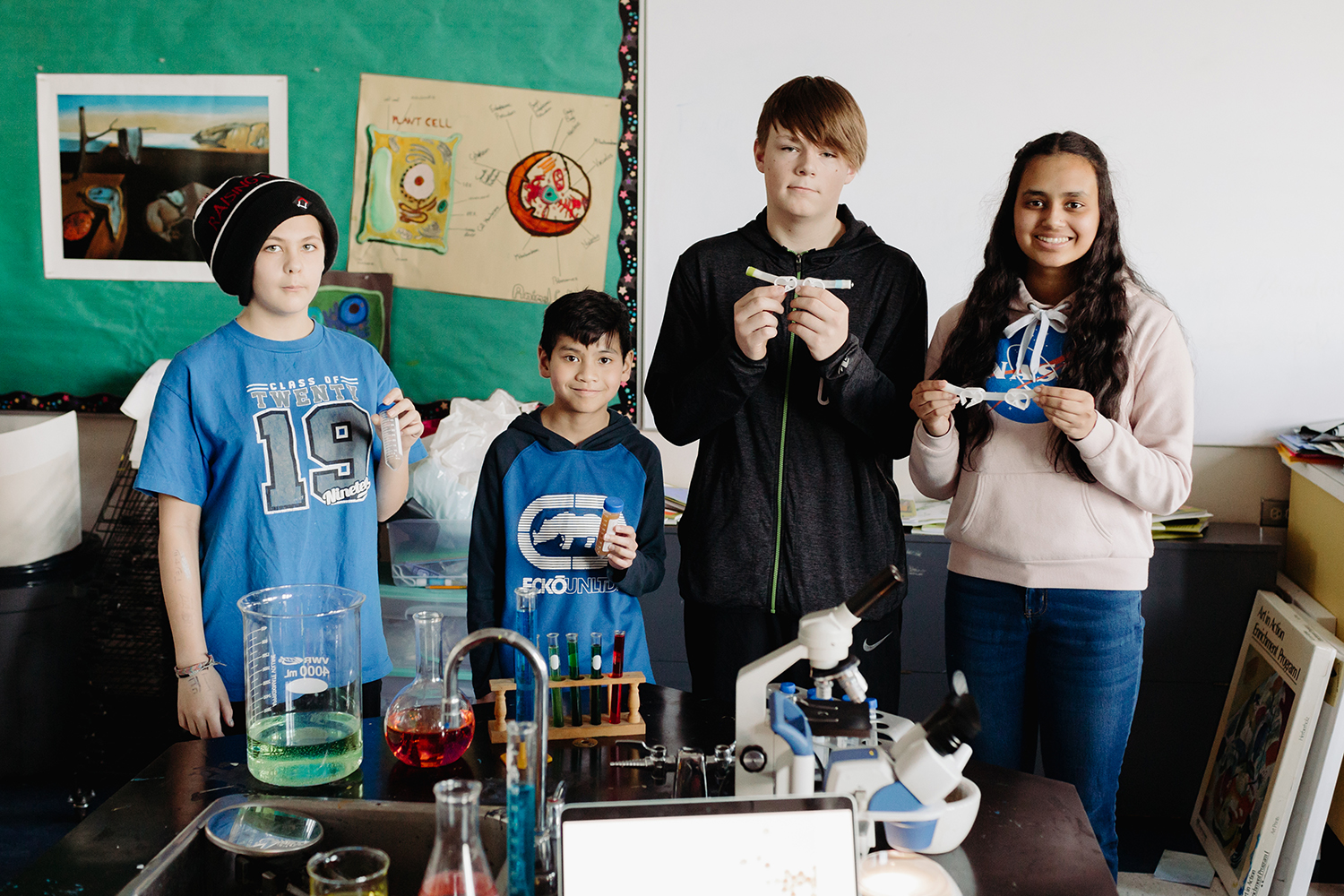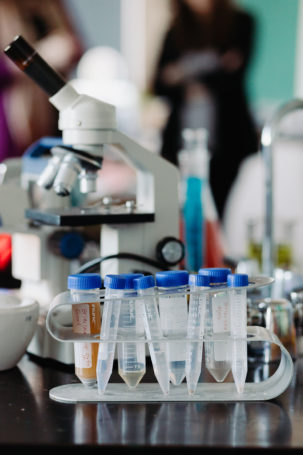June 19, 2020
Students send shrimp to the International Space Station as part of a NASA program that urges them to reach for the stars
They form an unlikely alliance, forged by destiny and tasked with a critical mission: To launch tiny, aquatic arthropods into space to see if they could become part of the postapocalyptic food chain that could nourish humanity on Earth and sustain the space explorers venturing to Mars, the gas giants and the infinite stars beyond.
Are they the Guardians of the Galaxy? No, they’re just four junior high school students whose miniature, self-contained science experiment will make a giant journey in July, rocketing 400 kilometres to the International Space Station for testing by astronauts and cosmonauts before returning to Edmonton at summer’s end.
So who are these bold and vicarious space explorers? Three are Grade 7 students from Rosslyn School: Adrien Hanna, a jokester in the style of Star-Lord (of Marvel Comics superhero fame), who has ambitions of becoming an MMA fighter; Maddy Keown, the hard-to-impress (but nice) version of Nebula, who dreams of becoming an artist or a chef; and Bradley Vith, reminiscent of the robotics-minded Rocket, who yearns for a future in e-sports. The eldest, and possibly the leader of this crew, is Sofia Sejutee, a Grade 9 student from Highlands School, who has the vision and intensity of Gamora plus the warmth of Mantis.
Their mission? To test the effects of microgravity on the reproduction and growth size of brine shrimp — better known, at least to generations of comic-book readers, as sea monkeys.

GRAVITY RULES IN THIS SCHOOL PROGRAM
Of course, being smart isn’t the only criterion to get an experiment onboard the space station. Thanks to financial support from Edmonton Community Foundation, junior high students from Edmonton Public Schools are participating for a second year in NASA’s Student Spaceflight Experiments Program (SSEP).
With help from their science or Career and Technology Foundations teachers, these enterprising (ahem) students will contribute in scientific research conducted in a laboratory moving at nearly eight kilometres per second in the near-Earth orbit, while helping fulfill the SSEP’s goal to promote youth achievement in mathematics, science, engineering and technology.
The student program was formed in 2010 as an initiative of the National Centre for Earth and Space Science Education in the United States, with support from the Arthur C. Clarke Institute for Space Education, the Smithsonian Institution’s National Air and Space Museum and the Center for the Advancement of Science in Space. It is a stunning opportunity for ambitious — to make a true contribution to space exploration.
And these aren’t just school arts and crafts, but real research projects conducted under the mentorship of university scientists. Program director Jeff Goldstein enthused in 2014 about the range of experiments involved in that year’s launch.
“Stem cell research, nanotubes, mutations of DNA fermentation in space, development of salamander eggs,” he said. “Really, a very wide variety of research disciplines.”
The major goal of SSEP, according to Goldstein, is to provide “an absolutely authentic immersion in every facet of real research” — and he doesn’t see age as an obstacle. “Researchers are in the business
of organized curiosity and evidence-based learning for the human race,” he said. “Our children are born curious … they’re fully capable of taking this on.”
Sejutee says it took about a week for the news to sink in that her experiment had been chosen for 2020’s mission. “My teachers were going insane,” she recalls. “At our winter dance, it was announced to our whole school and everyone was clapping and going crazy. It was very humbling.”
Reality began setting in as the teens participated in hands-on activities at the University of Alberta and then got a chance to talk about their mission with the media.
Sejutee is nearly vibrating as she says, “Sometimes in the middle of the night, I’ll just wake up and I’m like, ‘Oh, my god! My experiment’s going into space!’”

SPACE FOOD FOR THOUGHT
Contrary to popular belief, there is gravity in space, but its effects are minimal on human-scale activities. The microgravity environment of the near-Earth orbital zone, in which the space station travels, makes it an ideal location to understand how the absence of gravity affects normal physical processes on Earth — similar to comparing the effects of sunlight on marigolds by growing one in the dark and another in a bright greenhouse. Students choose research topics by looking at the effects of gravity on the world around them and wondering what would happen if they could turn the “gravity
switch” off.
The experiment itself will compare the growth patterns of brine shrimp cultivated aboard the space station against those grown on Earth with its gravitational force. The goal is to determine whether the shrimp could become a renewable food source.
Current “space rations” are formatted for long-term storage as well as the microgravity conditions that can cause a plate of rice to become a slowly spreading snowstorm.
While the crew on the International Space Station can choose from a menu of fruits, nuts, peanut butter, chicken, beef, seafood, candy and brownies, it’s hard to imagine anyone not becoming increasingly miserable spending months on end without fresh meat, fruit or vegetables. Crewed missions to Mars will require at least 30 weeks of travel each way, on top of the length of their surface mission.
Space travellers who don’t want to be at each other’s throats are going to need fresh and tasty things to consume — and that means growing them on their ships, stations and landing sites.
Brine shrimp are too tiny to grill on the barbecue — the largest might grow to be about the size of a Tic Tac breath mint — but they’re light and can survive in a dehydrated state, making them ideal candidates for an intergalactic grocery list.

TEAMWORK FOR THE WIN
In the two years since Edmonton Public Schools secured a berth on the rocket that sends experiments to International Space Station researchers, thousands of students from classrooms around the city compete for the coveted spot, researching topics, creating hypotheses and designing their experiments.
The mission in 2019 included an experiment, created by Grade 9 students at Edmonton’s David Thomas King School, on growing watercress seeds.
This year, the winning project included a new dimension: group work.
The “Guardians” alliance was formed when teachers from the two schools realized that each had students working on a brine shrimp project to submit to the SSEP program. The students were given a choice: go head-tohead to compete for the prized mission spot or collaborate. The students chose the latter.
The team assembled a “mini-lab” — a capsule containing dry brine shrimp eggs, salt water and algae, along with experiment instructions — that the International Space Station crew will use.
Vith knew “absolutely nothing” about brine shrimp before joining the project but his interest in the tiny creatures was piqued while reading about them in a list of NASA projects. “Because I saw they could withstand harsh environments, I thought, ‘Why not send them to space?’”
Keown explains that brine shrimp could be a key part of a future galactic ecosystem.
“On long-term missions, you need a food supply — you need to grow food [to] feed to other food,” he says. For example, a spaceship’s aquaculture system could have algae feeding the brine shrimp, the shrimp feeding the fish, and the fish feeding the crew.
Fish waste would become food for plant crops such as lettuce, tomatoes, cucumbers, squash, cabbage, strawberries, papaya and herbs.
“When you have brine shrimp grown and bred [as] a renewable food source for fish, which can then feed humans, it works really well, [and] brine shrimp can also be directly eaten by humans,” says Sejutee. “Brine shrimp and fish [are] very high in Omega-3 fatty acids, zinc, potassium, calcium — all the nutrients you need to keep a healthy cardiovascular system.”
Not all of these young Guardians are convinced that this space mission experience will change their lives.
Keown says he’s unlikely to pursue a future in science or space but Vith is considering something with robotics. Hanna notes that this will give him something to brag about when he’s grown into adulthood.
As for Sejutee, the Grade 9 student says the program has ignited her excitement about the life-long possibilities that could result from the mission.
“Definitely this experiment has opened more doors,” she says. “I never really thought about space before this as a career — but now, it’s really interesting!”